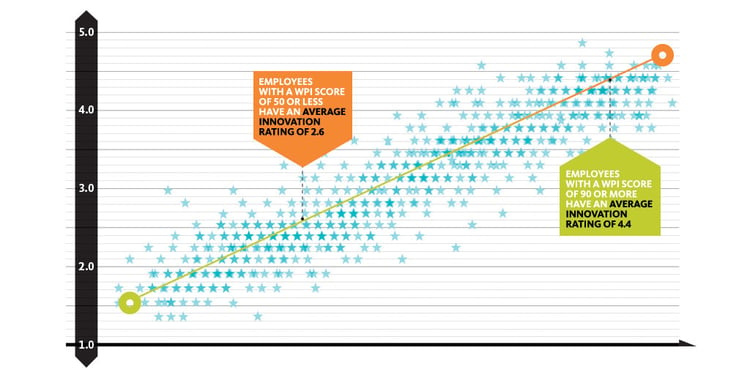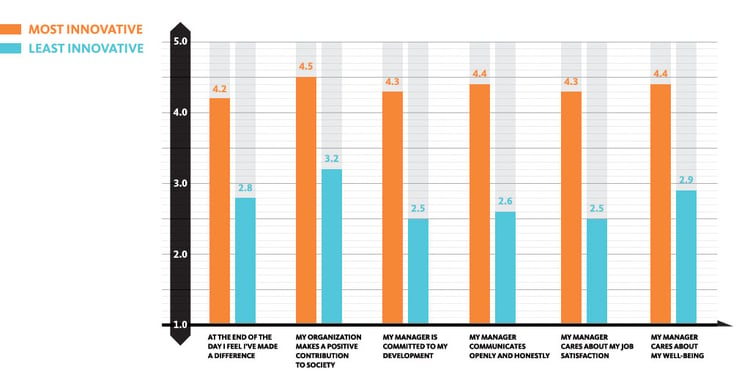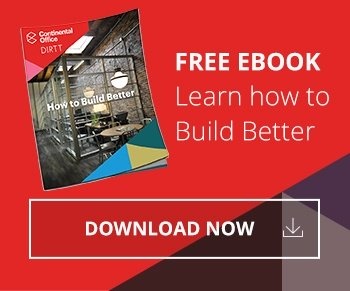Next to a company’s workforce, the second largest business expense for the vast majority of organizations is their real estate. Yet most organizations approach this expensive investment with a very narrow focus and short-term lens; resulting in spaces that can’t keep up with changing business demands and fail to foster a strong and vibrant culture. This short-term focus explains why the average tenant lease term is only 7 years in North America and is cause for serious concern, as we look to the future of commercial construction.
We’re entering a period of unprecedented change in workforce demographics and technology.
No one has a crystal ball, so predicting future workplace demands is a challenging, if not impossible, task for most executive teams and their facilities departments. One thing we know for sure is the antiquated approach of build-demolish-repeat imposes an enormous drain on resources and is increasingly expensive.
In today’s day and age, companies can’t afford not to innovate. Beyond the resource challenges and growing capital costs of just keeping up with a business’ needs, more and more research suggests there is a powerful correlation between innovative workplace design and overall employee happiness.
If you consider the tools in a company’s hiring and talent retention toolbox, they have three core resources available to help them hire the most attractive candidates and subsequently, keep those people engaged: (1) role/job description, (2) compensation and (3) workplace design/culture. The first two tools are table stakes when it comes to attracting and retaining talent and yet, they’re typically the tools that companies focus on most.
As just one point of reference, Gensler’s 2016 workplace study polled 4,000 people across 11 industries and revealed two important conclusions:
- A workplace’s performance correlates almost perfectly with a company’s level of innovativeness
Conclusion: Higher-performing workplaces are more innovative

- Only 56% of employees working in low performance offices for low innovation companies feel they make any kind of impact in their organizations; compared with 84% who feel they make a difference and work in high performance offices for innovative companies
- Only 50% of employees working in low performance offices feel their managers care about their job satisfaction and professional development; compared to 86% who feel their managers do care and work in high performance offices for innovative companies
Conclusion: Workplace innovation is directly tied to employee happiness and job satisfaction

What this research suggests is that office performance and design are intimately tied to company innovativeness and further, that innovation is innately correlated with employee satisfaction and retention.
So, how are the most innovative organizations rethinking their design and construction process, to maximize their footprint? And when investing in their space, how are these companies hedging against ever changing business needs? The answer is easy, they’re transforming their physical investments into strategic assets: innately future proof and flexible machines, that ebb and flow with their changing workforce and technology.
Lesson #1 – Walls: Expensive Barriers or Your Most Valuable Real Estate?
Maximizing your budget in today’s day and age can mean dramatically rethinking the types of work habits you choose to support. Unless the nature of your business demands it, lesson #1 is to be extremely purposeful about how you carve up your space. Vertical construction can be expensive, so maximize your budget by dividing space strategically— which may mean fewer walls— but be sure to put every surface to work. Each wall you do build should provide infrastructure to support your technology; reflect your culture through graphics and branding; or support employee collaboration.

Lesson #2 – Conventional Is Forever
When it comes to innovative companies, collaboration is key and of all the environments in a workplace, the spaces dedicated to collaborative group activities are subject to the most changes. These areas need to evolve regularly to meet the needs of a multitude of user groups and as such, their functions, technologies, and aesthetics need to adapt at the drop of a hat or companies risk lost productivity.
Conventional building methods are permanent and thus, lesson #2 in innovative workplace design is building with solutions that allow for flexibility and can easily adapt to accommodate future needs. Building with drywall and conventional electrical and networks wiring can make accommodating small changes a nightmare. Instead, consider construction alternatives that allow for ease of churn and can be quickly repurposed or retrofitted to address new technological challenges or infrastructure requirements.

Lesson #3 – Consider Your Impact
Innovative companies recognize their environments need to be more than just high performance, collaborative, and flexible. They understand their workplaces are an extension of the communities they operate in. As such, innovative organizations avoid designing in a vacuum and instead, focus on the overall lifetime of their spaces and the impact it will have on the environment around them. This starts day 1 with their approach to construction, as conventional means and methods are synonymous with waste; an estimated 1 pound for every square foot installed, per New York State’s Cornell University. As such, thousands of pounds of trash are produced during the conventional construction process, with even more created when the space is inevitably renovated or flipped years later. The result? Landfills throughout North America contain between 20 and 33 percent construction, renovation, and demolition waste and of that, up to 15 percent is drywall.
Lesson #3 is innovative companies realize this waste affects their bank account as much as it does the environment, as they’re paying for the material waste implicit in the initial construction process and later, demolition. And as such, these companies are keen to explore modern building alternatives such as modular prefab construction that can help them to minimize their initial footprint and allow for waste free change. Although, the additional work and alternative materials required to build sustainably may appear to come at a premium, closer attention reveals more often than not, that any added costs are balanced by long-term savings.

The Proof Is In The Pudding
Take Deloitte’s new 420K square foot headquarters in Toronto, Canada which pushes the boundaries of innovative, purposeful design to the extreme. This flagship office is a destination for some 4,000 employees and represents a huge departure from the traditional closed-office concept, synonymous with financial services firms. Though the 19-floor, hotel inspired space features premium amenities like a stylish private coffee shop, treadmill desks, woodsy lounges on every floor, and a spin studio, it didn’t break the bank. To finance the move, Deloitte dramatically changed their typical design, instead, dedicating 65 percent of the building to communal work spaces and doing away with reserved seating. Minimizing their environmental footprint was also a core goal on this project, made possible by using manufactured prefab construction. Waste was minimized by constructing most of the facility’s interior solid walls and electrical components in a factory; leveraging precision automation, assembly line material efficiencies, and centralized-recycling programs. Now that’s 21st century construction!
Once you’ve attracted the best and the brightest, you want to keep them! Having an adaptable workplace ensures you’re giving them everything they need to succeed; without ever having to face disruptive and wasteful construction. A space that constantly adapts to suit new technologies quietly and cleanly is a productive space, setting the stage for innovation and high employee engagement. Making them want to stay and giving them the tools to be the best they can be.





Comments